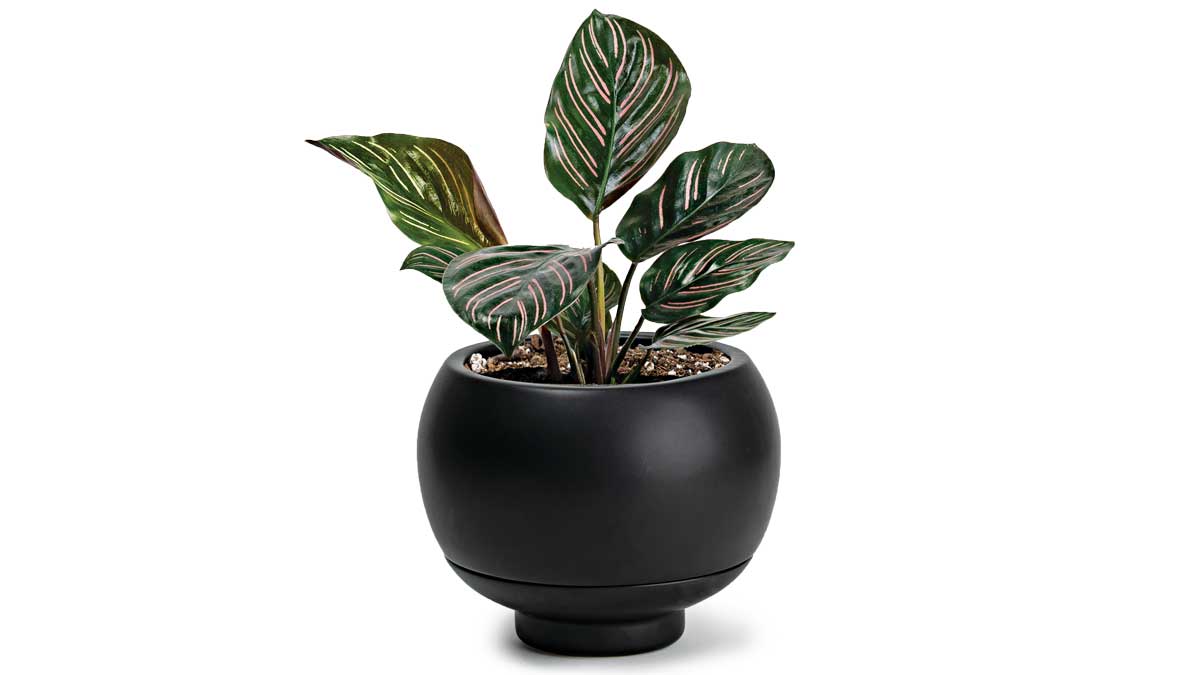
Prayer plants (Goeppertia spp. and cvs., syn. Calathea spp. and cvs., Zones 9–11) are arguably among the most stunning houseplants you can add to your collection. Though they come in many different shapes and styles, they are known for their distinctive foliage. The geometric, braidlike pattern on the leaves looks almost painted on. Prayer plants are also notable for the movement of their foliage throughout the day in a process known as nyctinasty. Like most plants in the Marantaceae family, they move their leaves up at night and lower them in the daytime in accordance to a circadian rhythm. Though the genus Calathea was recently reclassified as Goeppertia, you will still see them labeled as the former at most garden centers and online. Here are a few things to know when caring for these beautiful but finicky plants.
Tips for growing prayer plants
Provide indirect light and high humidity
Prayer plants need bright but indirect light to thrive; direct sun will cause the leaves to burn. These plants can tolerate lower light conditions indoors, but they require at least four to six hours of indirect light to maintain their vivid color and patterning. Prayer plants grow best in humid environments. Consider planting yours in a sub-irrigated planter or setting it on a pebble tray with water to increase the humidity around the plant. Frequent misting in winter can also help increase the relative humidity temporarily.
Keep the soil moist
These are water-loving plants that prefer consistency in soil moisture. Their soil should never be allowed to fully dry out. Prayer plants can be sensitive to some of the minerals and chemical treatments found in tap water and will exhibit browning along the edges of the leaves if they are exposed to too much of them. Consider watering with filtered water if you’re unsure about the salt and mineral content of your tap water. These are wonderfully expressive plants; if the soil is too dry, the leaves will curl inward, indicating that it is time for a drink. They are very resilient and generally bounce back from short droughts if they are watered adequately.
Three prayer plant species steal the show
Pinstripe prayer plant is a colorful classic
G. ornata (syn. C. ornata), Zones 9–11
This dark burgundy species is called pinstripe prayer plant for the bright pink stripes that run along broad, flat leaves. It can run on the larger side at 3 feet tall and wide, which helps to show off the beautiful reddish coloring on the underside of the leaves.
Rattlesnake prayer plant tolerates neglect
G. insignis (syn. C. lancifolia), Zones 9–11
This species is one of the most popular, and for good reason. The patterning of its leaves is unparalleled, and it’s very resilient if underwatered or overwatered. Smaller than pinstripe prayer plant, it will reach 1 to 2 feet tall and wide.
Peacock prayer plant has contrasting foliage
G. makoyana (syn. C. makoyana), Zones 9–11
This stunner’s foliage is bright and bold. The patterning looks particularly painted on, and the underside of the leaves exhibits incredible pink and purple hues that contrast with the green shades on the top of the leaves. This species will max out at 2 feet tall and wide.
What’s eating your prayer plant?
Spider mites love prayer plants. You can recognize an infestation by observing spotted or curling leaves, often with webbing. The insects themselves are extremely small and may not be visible to the naked eye. Regularly misting and wiping the leaves of your plant with a microfiber cloth will do wonders to keep these pests at bay. Be sure to spray the underside of the leaves, where pests often hide. For intense infestations, consider an organic product such as Mite-X or a horticultural oil.
Rebecca Bullene is the cofounder of Greenery Unlimited, a Brooklyn-based and online plant shop.






















Comments
Grub Controlit is not easy to grow turf and plants, and what is even worse is all the work that comes before doing it. Hire the best soil and Ph testing service, and let the experts from Green Scene Landscaping handle what they know best. Contact us to know more!
Log in or create an account to post a comment.
Sign up Log in